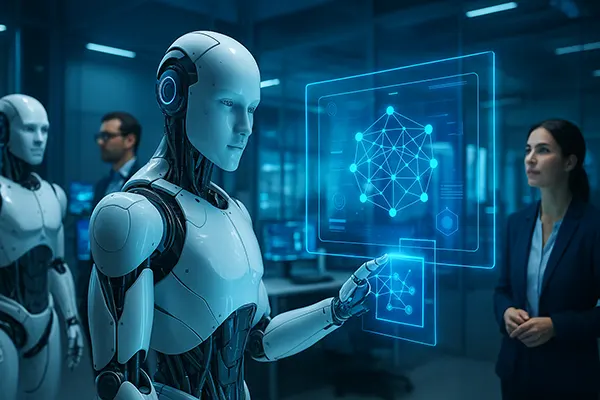
The Development of Artificial Intelligence at the Edge of AGI
Artificial Intelligence (AI) has evolved from narrow systems designed to perform specific tasks to increasingly complex architectures capable of reasoning, creativity, and adaptation. As we enter 2025, the frontier between specialised AI and Artificial General Intelligence (AGI) is becoming increasingly blurred. The progress achieved in cognitive modelling, neural scaling, and multi-modal reasoning demonstrates that the concept of a machine with general human-like intelligence is no longer a distant vision but a developing reality.
The Path Towards Artificial General Intelligence
The journey towards AGI began with the development of narrow AI systems that could outperform humans in individual domains, such as strategic games or image recognition. However, these systems lacked the flexibility and contextual awareness that define general intelligence. The latest advances in reinforcement learning, large language models, and hybrid architectures now aim to bridge that gap. Researchers are increasingly combining symbolic reasoning with neural learning to create systems that can learn abstract concepts and apply them across various tasks.
Another major step forward is the integration of self-reflective and metacognitive processes within AI systems. This enables models not only to process information but also to evaluate their reasoning patterns, identify errors, and improve autonomously. Such abilities are central to the definition of AGI, as they mirror human cognitive adaptability — the capacity to learn continuously from limited data and real-world feedback.
Furthermore, the role of data efficiency and unsupervised learning has become vital. The shift away from massive datasets towards quality-driven and context-aware learning techniques reflects a move towards more sustainable and intelligent training. These methods not only reduce computational waste but also bring AI closer to genuine understanding rather than simple pattern prediction.
Milestones and Current Developments
Recent breakthroughs have pushed the limits of what was once thought impossible. In 2025, multi-agent collaboration environments are used to simulate collective intelligence, allowing AI models to share insights and evolve through interaction. This approach mirrors social learning, one of the core principles of human intelligence. As a result, models now exhibit problem-solving behaviours that appear increasingly intuitive and strategic.
The introduction of reasoning-based architectures has also revolutionised the field. Unlike traditional neural networks that rely on probabilistic patterns, these models use structured logical frameworks to evaluate cause and effect. This has led to the creation of AI systems capable of producing transparent explanations for their decisions — a key factor in building trust and accountability in human-AI cooperation.
Alongside research institutions, private companies are developing experimental AGI prototypes that demonstrate general problem-solving across domains. These prototypes can learn new skills without task-specific retraining, marking an essential step toward achieving the adaptability that defines human cognition. The collaboration between academia and industry has never been more crucial to ensuring safe and transparent AGI development.
Ethical Implications and Societal Impact
The rise of AGI raises profound ethical and societal questions. Unlike narrow AI systems, AGI could make autonomous decisions affecting economies, politics, and human welfare. The challenge lies not only in controlling such systems but also in defining moral and legal frameworks that align machine reasoning with human values. The emergence of digital consciousness — the possibility that an AGI could develop self-awareness — has reignited debates around rights, responsibility, and accountability.
Governments and international organisations are now drafting global standards for AGI governance. The emphasis is shifting from technological competition to cooperative regulation, as the potential consequences of unregulated AGI could be global. From data privacy to algorithmic bias and economic disruption, societies must prepare for transformations that go beyond technical innovation and into social philosophy.
Public trust remains a critical component of progress. Transparency in AI decision-making, accessible documentation, and independent auditing are essential to maintain human oversight. Without public confidence, even the most advanced AGI models could face widespread resistance, delaying integration and the potential benefits they bring.
Balancing Innovation and Responsibility
Responsible innovation requires collaboration between policymakers, ethicists, and technologists. Establishing ethical frameworks early in AGI’s evolution ensures that innovation does not outpace moral responsibility. AI safety research, once a niche field, is now at the forefront of global scientific agendas, focusing on interpretability, robustness, and alignment with human intentions.
Moreover, interdisciplinary cooperation — combining insights from neuroscience, linguistics, philosophy, and computer science — is shaping the next stage of AGI design. By understanding the mechanisms of human cognition, researchers can create systems that not only imitate intelligence but understand the context and emotion behind human decision-making.
As AGI approaches realisation, the need for continuous monitoring and adaptive regulation grows stronger. Ethics cannot remain static in the face of exponential technological change. Instead, governance models must evolve dynamically alongside AGI systems, ensuring that humanity retains control over technology that could redefine existence itself.

The Future of Human-AI Collaboration
AGI is not expected to replace humanity but to redefine collaboration. The combination of human creativity and machine precision could solve problems that have long eluded traditional methods — from climate modelling to medical innovation. Hybrid intelligence systems, where humans and AI work symbiotically, are already emerging across multiple industries, enhancing productivity and creative discovery.
Education systems are beginning to adapt to this new paradigm. In 2025, universities and training programmes are focusing on AI literacy, ethics, and interdisciplinary knowledge to prepare future generations for coexistence with intelligent systems. Understanding how to collaborate effectively with AGI will become as essential as learning to use the internet once was.
Ultimately, the real measure of progress will not be when AGI surpasses human intelligence but when it complements it. The goal is not competition but coexistence — an ecosystem in which AI amplifies human potential rather than replacing it. The challenge ahead lies in maintaining this balance as innovation accelerates beyond our historical experience.
Anticipating the Next Era
Looking ahead, the defining factor for AGI’s success will be humanity’s capacity for foresight and cooperation. The convergence of ethical governance, transparent innovation, and cross-border collaboration will determine whether AGI becomes a tool for progress or a catalyst for instability. As nations invest heavily in artificial cognition, shared values must form the cornerstone of future AI governance.
Technological history suggests that once a system achieves general intelligence, progress accelerates irreversibly. Preparing for that moment — socially, legally, and philosophically — is imperative. The coming years will demand not just technological advancement but maturity in how we define intelligence, agency, and human purpose.
The development of AGI stands as one of humanity’s greatest achievements and responsibilities. Whether it leads to a golden age of innovation or to unforeseen challenges depends not only on engineers and scientists but on collective human wisdom. The boundary between AI and AGI is not just a technological frontier — it is a moral and existential one.
